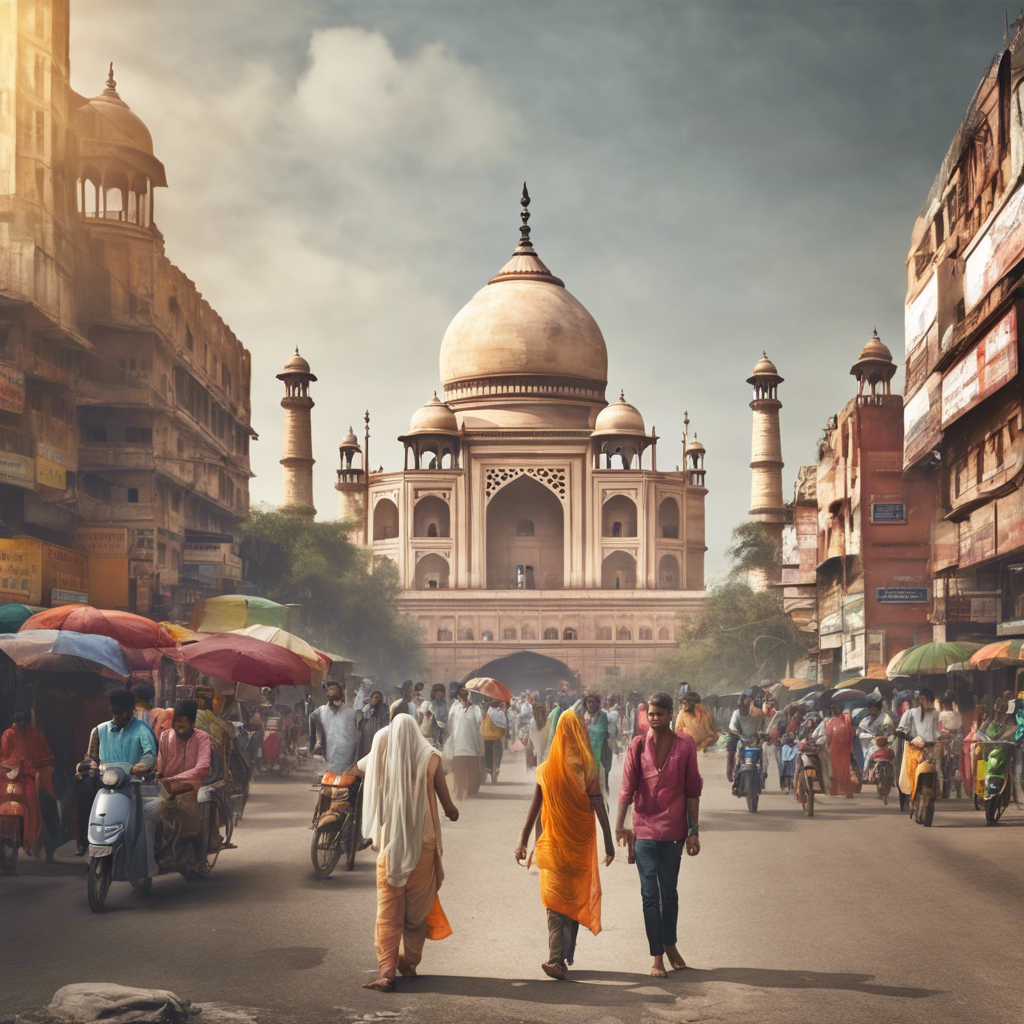
Marvelling at the Taj Mahal at Sunrise: An Unforgettable Adventure in 2024:
Imagine a world where love transcends time and space, where a single monument stands as a testament to the depths of human emotion. Welcome to the Taj Mahal, a breathtaking marble mausoleum that has captivated the hearts and minds of millions. And what better way to experience its magic than at the crack of dawn, when the first rays of the sun dance across its pristine surface?
In this comprehensive guide, we’ll take you on a journey through the enchanting world of the Taj Mahal, exploring its rich history, stunning architecture, and the best ways to make the most of your visit in 2024. From the perfect time to visit to the top attractions and activities, we’ve got you covered. So, grab your camera, put on your adventure hat, and let’s dive into the world of the Taj Mahal!
The History of the Taj Mahal: A Love Story for the Ages:
The Taj Mahal, a UNESCO World Heritage Site, is a true masterpiece of Mughal architecture. Built by the Mughal emperor Shah Jahan as a mausoleum for his beloved wife, Mumtaz Mahal, the Taj Mahal is a testament to the power of love. Construction began in 1632 and took over 20 years and 20,000 workers to complete.
The Taj Mahal is a perfect example of symmetry, with its four identical sides and a central dome flanked by four smaller domes. The intricate carvings, inlaid precious stones, and calligraphy adorning the walls are a true feast for the eyes.
The Taj Mahal, an iconic symbol of love and architectural brilliance, was commissioned by the Mughal Emperor Shah Jahan in memory of his beloved wife, Mumtaz Mahal. This ivory-white marble mausoleum, located on the banks of the Yamuna River in Agra, India, is not only a UNESCO World Heritage Site but also one of the New Seven Wonders of the World. Its construction began in 1632 and was completed in 1653, involving over 20,000 artisans and workers from various regions, including Persia and Europe.
A Love Story that Inspired a Monument
Shah Jahan’s love for Mumtaz Mahal was profound. She was not only his wife but also his confidante and companion. Their love story began in 1612 when they married, and it flourished until her untimely death during childbirth in 1631. Heartbroken, Shah Jahan vowed to build a magnificent mausoleum that would immortalize her memory. The Taj Mahal was conceived as a symbol of his undying love and devotion, a “teardrop on the cheek of time,” as poet Rabindranath Tagore famously described it.
Architectural Marvel
The Taj Mahal is celebrated for its exquisite architecture, which blends elements of Islamic, Persian, Ottoman Turkish, and Indian styles. The main structure features a large dome surrounded by four smaller domes, and it is flanked by four elegant minarets. The intricate inlay work of semi-precious stones, including lapis lazuli and jade, enhances its beauty, making it a masterpiece of Mughal architecture.
The entire complex spans approximately 17 hectares (42 acres) and includes lush gardens, reflecting pools, and various ancillary buildings, such as a mosque and a guest house. The gardens are designed in a char bagh (four-fold) layout, symbolizing paradise in Islamic culture. The meticulous planning and execution of the Taj Mahal’s design reflect the zenith of Mughal architectural achievement.
The Construction Process
The construction of the Taj Mahal was a monumental task that took over two decades to complete. The mausoleum itself was finished in 1648, but the surrounding structures and gardens were completed five years later. The estimated cost of the project was around ₹32 million at the time, equivalent to approximately ₹35 billion (US$77.8 million) today.
Shah Jahan’s vision for the Taj Mahal was so grand that he initially planned to build a second mausoleum made of black marble across the river, intended for himself. However, after being deposed by his son Aurangzeb, he spent his final years imprisoned in Agra Fort, where he could only gaze at the Taj Mahal from a distance.
Cultural Significance and Legacy
The Taj Mahal has transcended its original purpose as a mausoleum to become a symbol of love and an enduring testament to the artistic and cultural achievements of the Mughal Empire. It attracts millions of visitors each year, making it one of the most popular tourist destinations in the world. Its designation as a UNESCO World Heritage Site in 1983 further solidified its status as a global cultural treasure.
Despite facing challenges such as pollution and neglect over the years, restoration efforts have been undertaken to preserve its beauty and integrity. The Taj Mahal remains a source of inspiration for poets, artists, and lovers alike, embodying the idea that true love can create something eternal.
The Taj Mahal is more than just an architectural wonder; it is a poignant reminder of the power of love and the lengths to which one man went to honor his beloved. Its beauty continues to captivate hearts and minds, making it a timeless symbol of devotion that resonates with people around the world. Whether viewed at sunrise, when the marble glows with a soft, ethereal light, or at sunset, when it takes on a golden hue, the Taj Mahal remains a breathtaking testament to the enduring nature of love.
The Best Time to Visit: Sunrise at the Taj Mahal:
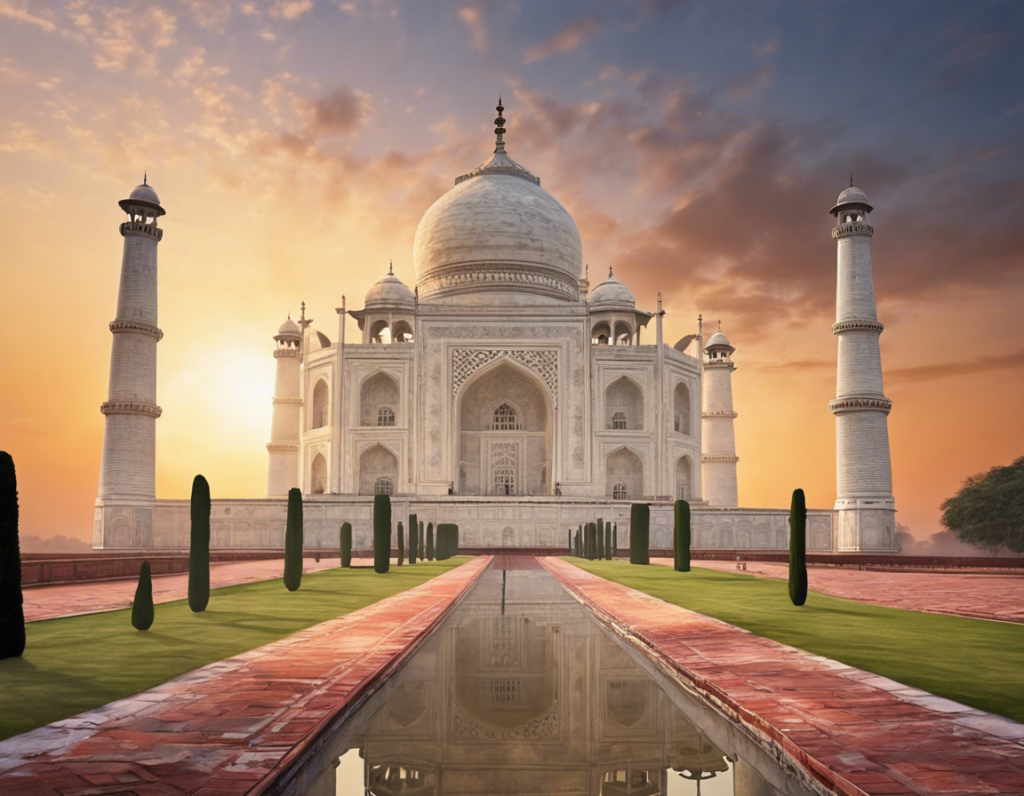
Experiencing the Taj Mahal at sunrise is often described as one of the most magical moments one can witness. The soft light of dawn casts a warm glow on the pristine white marble, creating a breathtaking spectacle that leaves visitors in awe. Here’s a detailed exploration of why sunrise is the best time to visit the Taj Mahal, along with practical tips to enhance your experience.
The Magic of Sunrise at the Taj Mahal
The Taj Mahal opens its gates half an hour before sunrise, allowing visitors to enter and find their spots as the first light begins to illuminate the monument. This timing is crucial, as the sunrise typically occurs between 5:15 AM and 5:45 AM, depending on the season. The gradual transition from darkness to light enhances the monument’s ethereal beauty, making it a photographer’s paradise.
As the sun rises, the marble façade of the Taj Mahal reflects hues of pink and orange, creating a stunning visual contrast against the deep blue sky. This phenomenon not only highlights the intricate details of the monument but also provides a serene atmosphere, often free from the usual crowds that flock to the site later in the day.
Why Sunrise is the Best Time to Visit
Less Crowded: Visiting at sunrise allows you to enjoy the Taj Mahal with fewer people around. This tranquil setting enhances the experience, allowing for uninterrupted moments of reflection and appreciation of the monument’s beauty.
Perfect Lighting for Photography: The soft morning light is ideal for photography. It accentuates the Taj Mahal’s architectural features and the surrounding gardens, making every shot a potential masterpiece.
Unique Atmosphere: The early morning mist adds a layer of mystique to the experience. The gentle fog can create a dreamy backdrop, making the Taj Mahal appear even more enchanting.
Cooler Temperatures: Visiting early in the morning means cooler temperatures, especially during the hot summer months. This makes for a more comfortable exploration of the site.
A Memorable Start to the Day: Witnessing the sunrise at the Taj Mahal is not just a visual treat but also a deeply emotional experience, often described as a spiritual moment that sets a positive tone for the rest of the day.
Planning Your Sunrise Visit
To make the most of your sunrise experience at the Taj Mahal, consider the following tips:
Arrive Early: Aim to arrive at least 45 minutes before sunrise to allow time for security checks and to find a good spot. The gates open half an hour before sunrise, and queues can form quickly.
Purchase Tickets in Advance: To avoid long lines, consider purchasing your tickets online. This can save you time and ensure you get in as early as possible.
Choose the Right Entrance: The East Gate is often less crowded than the West Gate, making it a better option for early morning visits.
Dress Comfortably: Wear comfortable shoes and clothing suitable for the weather. Layers are recommended as it can be cool in the early morning but warm up as the sun rises.
Plan for Breakfast: After your visit, enjoy breakfast at one of Agra’s renowned restaurants. Many sunrise tours include breakfast options, allowing you to savor local cuisine after your early morning adventure.
Suggested Sunrise Tour Itinerary
For those looking to book a sunrise tour, here’s a typical itinerary:
2:30 AM: Pickup from your hotel in Delhi.
3:00 AM: Depart for Agra via private, air-conditioned vehicle. The drive takes approximately 3-3.5 hours.
6:00 AM: Arrive in Agra and proceed to the Taj Mahal.
6:15 AM: Enter the Taj Mahal grounds as the sun begins to rise. Spend time exploring the monument and capturing photos.
8:00 AM: After touring the Taj Mahal, enjoy breakfast at a local restaurant.
9:30 AM: Visit Agra Fort or other nearby attractions such as Itimad-ud-Daulah (Baby Taj).
12:00 PM: Return to Delhi, concluding your memorable sunrise experience.
Witnessing the Taj Mahal at sunrise is an unforgettable experience that combines natural beauty, historical significance, and emotional resonance. The tranquility of the early morning hours, coupled with the stunning visual transformation of the monument, makes it a must-do for anyone visiting Agra. So, set your alarm, grab your camera, and prepare to be mesmerized by one of the world’s most iconic landmarks bathed in the golden light of dawn.
Top Attractions at the Taj Mahal:
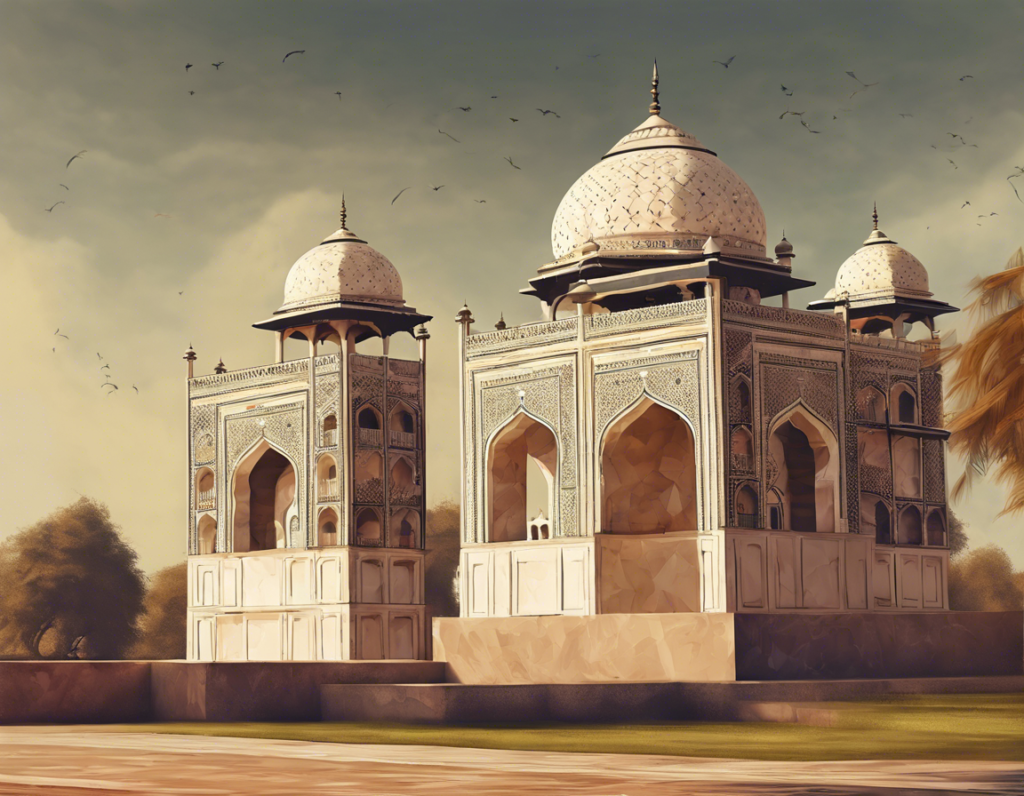
The Taj Mahal, a UNESCO World Heritage Site and one of the Seven Wonders of the World, is not only a stunning architectural marvel but also a treasure trove of attractions that enhance its allure. Here’s an exploration of the top attractions within the Taj Mahal complex and its surroundings that every visitor should experience.
1. The Taj Mahal Mausoleum
At the heart of the complex lies the Taj Mahal mausoleum, an exquisite structure made of white marble that changes color throughout the day. The central dome, which rises to about 35 meters, is flanked by four smaller domes and four elegant minarets, creating a perfect symmetry that is a hallmark of Mughal architecture. Inside, the cenotaphs of Shah Jahan and Mumtaz Mahal are intricately decorated, showcasing the craftsmanship of the artisans who built this magnificent monument.
2. The Gardens
The Taj Mahal is surrounded by beautifully landscaped gardens, designed in the Persian char bagh style, which symbolize paradise in Islamic culture. The gardens are divided into four quadrants by water channels, with fountains and reflecting pools that mirror the beauty of the mausoleum. This serene setting is perfect for leisurely walks and provides stunning photographic opportunities, especially during sunrise and sunset.
3. The Main Gateway (Darwaza)
As you enter the Taj Mahal complex, you are greeted by the grand main gateway, known as the Darwaza. This impressive structure features intricate carvings and calligraphy, setting the tone for the architectural splendor that awaits inside. The gateway provides a stunning first glimpse of the Taj Mahal, framed perfectly by its arches.
4. The Mosque (Masjid)
To the left of the Taj Mahal is the mosque, built with red sandstone. This structure not only serves a religious purpose but also adds to the aesthetic appeal of the complex. Visitors can admire the intricate details of the mosque’s architecture while enjoying the peaceful ambiance it offers.
5. The Guest House (Naqqar Khana)
On the right side of the mausoleum lies the guest house, or Naqqar Khana, which was used to accommodate visitors. This building mirrors the mosque in design and serves as a beautiful complement to the overall symmetry of the Taj Mahal complex.
6. Mehtab Bagh
Located across the Yamuna River, Mehtab Bagh offers one of the best views of the Taj Mahal, especially at sunset. This garden complex is less crowded than the main site, making it an ideal spot for a peaceful retreat. The reflection of the Taj Mahal in the river adds to the romantic atmosphere, making it a popular spot for couples.
7. Agra Fort
Just a short distance from the Taj Mahal, Agra Fort is another UNESCO World Heritage Site that should not be missed. This massive red sandstone fortress was the main residence of the Mughal emperors until the capital was moved to Delhi. The fort offers stunning views of the Taj Mahal from its ramparts and is rich in history, with beautiful palaces, gardens, and mosques within its walls.
8. Tomb of Itimad-ud-Daulah (Baby Taj)
Often referred to as the “Baby Taj,” this tomb is a precursor to the Taj Mahal and showcases similar architectural elements. It is the tomb of Mirza Ghiyas Beg, the father of Empress Nur Jahan. The intricate marble inlay work and the serene gardens surrounding this site make it a worthwhile visit.
9. The Yamuna River
The Yamuna River, which flows beside the Taj Mahal, adds to the charm of the monument. A boat ride on the river provides a unique perspective of the Taj Mahal, especially during sunrise or sunset when the monument is bathed in golden light.
10. Local Markets
Exploring the local markets in Agra is a delightful way to experience the culture and craftsmanship of the region. From marble inlay work to traditional handicrafts, visitors can find unique souvenirs to take home. The bustling bazaars also offer a taste of local cuisine, making it a vibrant part of the Agra experience.
Conclusion
The Taj Mahal is not just a single monument but a complex of attractions that together create an unforgettable experience. From the breathtaking beauty of the mausoleum to the serene gardens and surrounding historical sites, each element contributes to the rich tapestry of history and culture that defines Agra. Whether you’re a history enthusiast, a romantic couple, or a family looking for adventure, the Taj Mahal and its attractions offer something for everyone.
Top 10 Things for Couples to Do at the Taj Mahal:
Here are the top 10 things for couples to do at the Taj Mahal:
- Take a romantic stroll through the gardens: Holding hands, explore the lush greenery of the Taj Mahal gardens, stopping to admire the stunning views of the monument.
- Pose for a picture in front of the iconic monument: Strike a romantic pose in front of the Taj Mahal and capture a moment that will last a lifetime.
- Enjoy a picnic in the Mehtab Bagh: Pack a delicious lunch and head to the Mehtab Bagh, located across the river, for a romantic picnic with a view of the Taj Mahal.
- Explore the intricate carvings and calligraphy: Discover the hidden details that make the Taj Mahal so special, like the intricate carvings and calligraphy adorning the walls.
- Watch the sunset over the Taj Mahal: As the day draws to a close, find a quiet spot to watch the sun dip below the horizon, casting a warm glow over the Taj Mahal.
- Visit the Tomb of Itimad-ud-Daulah: Also known as the “Baby Taj,” this stunning mausoleum is a must-visit for couples who want to explore more of Agra’s architectural wonders.
- Take a romantic horse-drawn carriage ride: For a truly magical experience, take a horse-drawn carriage ride around the Taj Mahal and soak in the atmosphere.
- Enjoy a candlelit dinner at a nearby restaurant: After a day of exploring, treat yourselves to a romantic candlelit dinner at one of Agra’s top restaurants.
- Visit the Agra Fort: This impressive red sandstone fortress is a UNESCO World Heritage Site and offers stunning views of the Taj Mahal.
- Explore the local markets: Agra is famous for its handicrafts, including marble inlay work, carpets, and leather goods. Spend an afternoon exploring the local markets and haggling for the perfect souvenir.
Top 15 Things for Families to Do at the Taj Mahal:
Visiting the Taj Mahal is an unforgettable experience for families. The monument not only offers a glimpse into India’s rich history but also provides numerous activities that can engage and entertain children of all ages. Here are the top 15 things for families to do at the Taj Mahal:
1. Explore the Taj Mahal Gardens
The sprawling gardens surrounding the Taj Mahal are perfect for families to explore. Kids can run around, enjoy the lush greenery, and take in the stunning views of the monument. The gardens are designed in a Persian style, symbolizing paradise, and provide ample space for family photos.
2. Visit Agra Fort
Just a short distance from the Taj Mahal, Agra Fort is another UNESCO World Heritage Site that offers a fascinating look into Mughal history. Kids will enjoy exploring the fort’s massive walls, beautiful palaces, and stunning views of the Taj Mahal from its ramparts.
3. Take a Boat Ride on the Yamuna River
A boat ride on the Yamuna River offers a unique perspective of the Taj Mahal. Families can enjoy a leisurely cruise while spotting various bird species and taking in the picturesque views of the monument from the water.
4. Participate in a Guided Tour
Hiring a knowledgeable guide can enhance the experience for families. A guide can share intriguing stories and historical facts about the Taj Mahal, making the visit more engaging for children.
5. Capture Family Photos
The Taj Mahal is one of the most photographed monuments in the world. Families should take advantage of the beautiful backdrops to capture memorable family photos. The early morning light provides the best conditions for stunning pictures.
6. Visit the Tomb of Itimad-ud-Daulah (Baby Taj)
Known as the “Baby Taj,” this mausoleum is a smaller yet equally beautiful structure that offers a quieter experience. Itimad-ud-Daulah’s Tomb features intricate inlay work and serene gardens, making it a great spot for families to explore.
7. Enjoy a Picnic in Mehtab Bagh
Located across the river from the Taj Mahal, Mehtab Bagh is an ideal spot for a family picnic. The gardens provide a stunning view of the Taj Mahal, especially at sunset, and are less crowded than the main site.
8. Visit the Wildlife SOS Elephant Conservation Center
For families interested in wildlife, a visit to the Wildlife SOS Elephant Conservation Center is a must. This sanctuary is dedicated to rescuing and rehabilitating elephants, and families can learn about these gentle giants while observing them in a safe environment.
9. Explore Local Markets
Agra is known for its vibrant markets filled with handicrafts, textiles, and souvenirs. Families can spend an afternoon exploring the local bazaars, picking up unique items, and experiencing the local culture.
10. Enjoy Rooftop Dining
After a day of exploring, families can enjoy a meal at one of Agra’s rooftop restaurants. Many offer stunning views of the Taj Mahal, allowing families to relax and enjoy the scenery while savoring local cuisine.
11. Attend Cultural Performances
Check for local cultural performances or events happening in Agra during your visit. These can provide families with a deeper understanding of Indian culture and traditions.
12. Visit the Jama Masjid
The Jama Masjid, one of the largest mosques in India, is located near the Taj Mahal. Families can explore its beautiful architecture and learn about its significance in the local community.
13. Take a Cycle Rickshaw Ride
Exploring Agra by cycle rickshaw can be a fun and unique experience for families. It allows parents and children to see the city from a different perspective while enjoying the fresh air.
14. Discover the History of the Taj Mahal
Before visiting, families can read about the history of the Taj Mahal, including the love story of Shah Jahan and Mumtaz Mahal. Understanding the background can make the visit more meaningful and engaging for children.
15. Relax in the Gardens
After exploring, families can take some time to relax in the gardens surrounding the Taj Mahal. The peaceful atmosphere provides a perfect opportunity for kids to unwind and enjoy the beauty of their surroundings.
The Taj Mahal offers a wealth of experiences for families, combining history, culture, and natural beauty. From exploring the gardens and nearby attractions to engaging in fun activities, there is something for everyone to enjoy. A visit to this iconic monument is sure to create lasting memories for families visiting Agra.
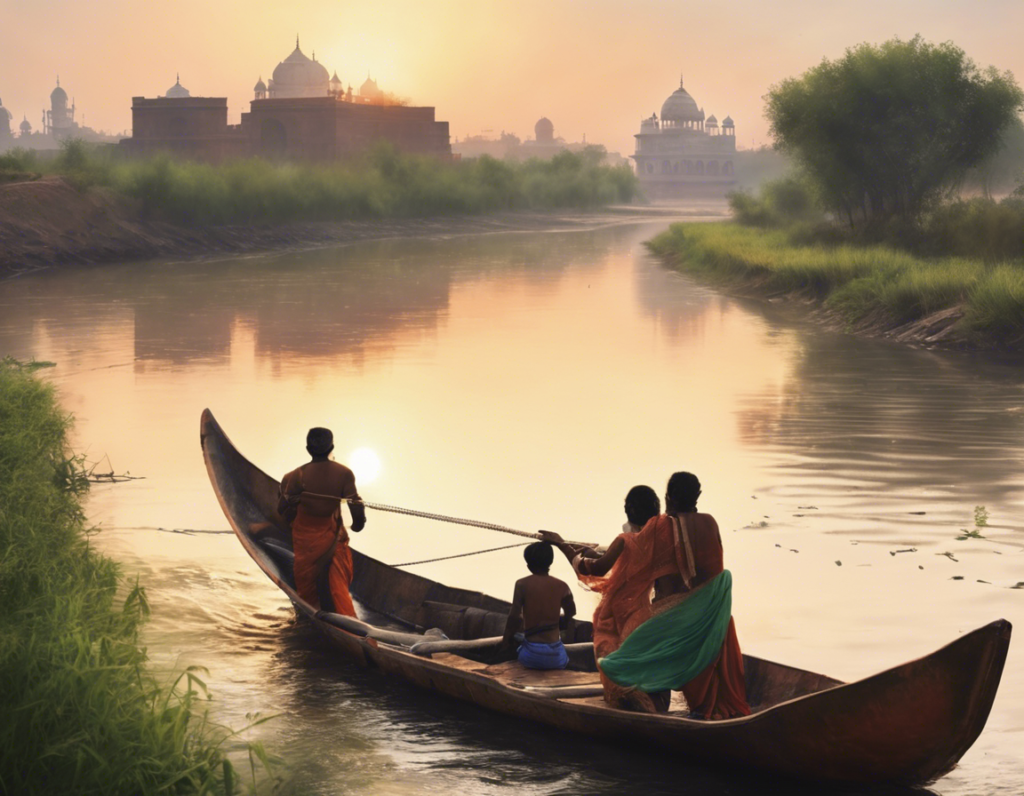
Top Restaurants and Cuisine in Agra:
Agra, the home of the iconic Taj Mahal, is also known for its delectable cuisine that blends Mughlai and North Indian flavors. From traditional kebabs to rich curries, Agra offers a diverse culinary experience for food enthusiasts. Here are some of the top restaurants and must-try dishes in Agra:
Esphahan
Located inside the luxurious Oberoi Amarvilas hotel, Esphahan is one of the finest traditional restaurants in Agra. It offers a limited number of candlelit tables for dinner, with reservations required in advance. The menu features a selection of delicious North Indian tandoori dishes, such as the bharwan aloo (stuffed potato kebab) and Mughal lamb kebab stuffed with prunes. The restaurant also features live santoor (stringed instrument) music, creating a romantic and memorable dining experience.
Dasaprakash
For those seeking South Indian flavors, Dasaprakash is a popular restaurant that serves authentic dosas, idlis, and other South Indian dishes. It’s a great option for vegetarians looking for a break from North Indian cuisine.
Pinch of Spice
This restaurant is known for its delicious curries and tandoori dishes, showcasing the rich flavors of Mughlai cuisine. It’s a favorite among locals and tourists alike.
Joney’s Place
Located near the Taj Mahal, Joney’s Place is a casual restaurant famous for its kebabs and biryanis. It offers a mix of North Indian, Japanese, and Korean specialties in a basic setting.
Shankara Vegis Restaurant
For vegetarians, Shankara Vegis Restaurant offers a range of North Indian and South Indian vegetarian dishes, catering to various dietary preferences.
Local Street Food
Agra’s streets are dotted with vendors selling delicious snacks like samosas, kachoris, chaats, and jalebis. These street food stalls offer a taste of authentic local flavors at affordable prices.
Petha
No visit to Agra is complete without trying the famous “petha,” a soft, translucent candy made from ash gourd (winter melon). It’s available in various flavors, including plain, saffron, and more.
Mughlai Cuisine
Agra has a rich culinary heritage, with Mughlai cuisine being a highlight. Don’t miss out on dishes like biryani, kebabs, and rich curries that showcase the city’s Mughal influence.
Rooftop Restaurants in Taj Ganj
The Taj Ganj area near the Taj Mahal is home to several rooftop restaurants and cafes offering both local and international cuisine. These establishments provide stunning views of the iconic monument while you savor delicious meals.
Local Markets
Exploring the local markets in Agra is a great way to discover unique spices, sweets, and crafts. You can also find a variety of street food stalls serving up tasty treats.
When it comes to dining in Agra, the options are endless. From traditional Mughlai dishes to South Indian specialties and street food delights, there’s something to satisfy every palate. Whether you’re a foodie or simply looking for a memorable culinary experience, Agra’s restaurants and cuisine are sure to leave a lasting impression.
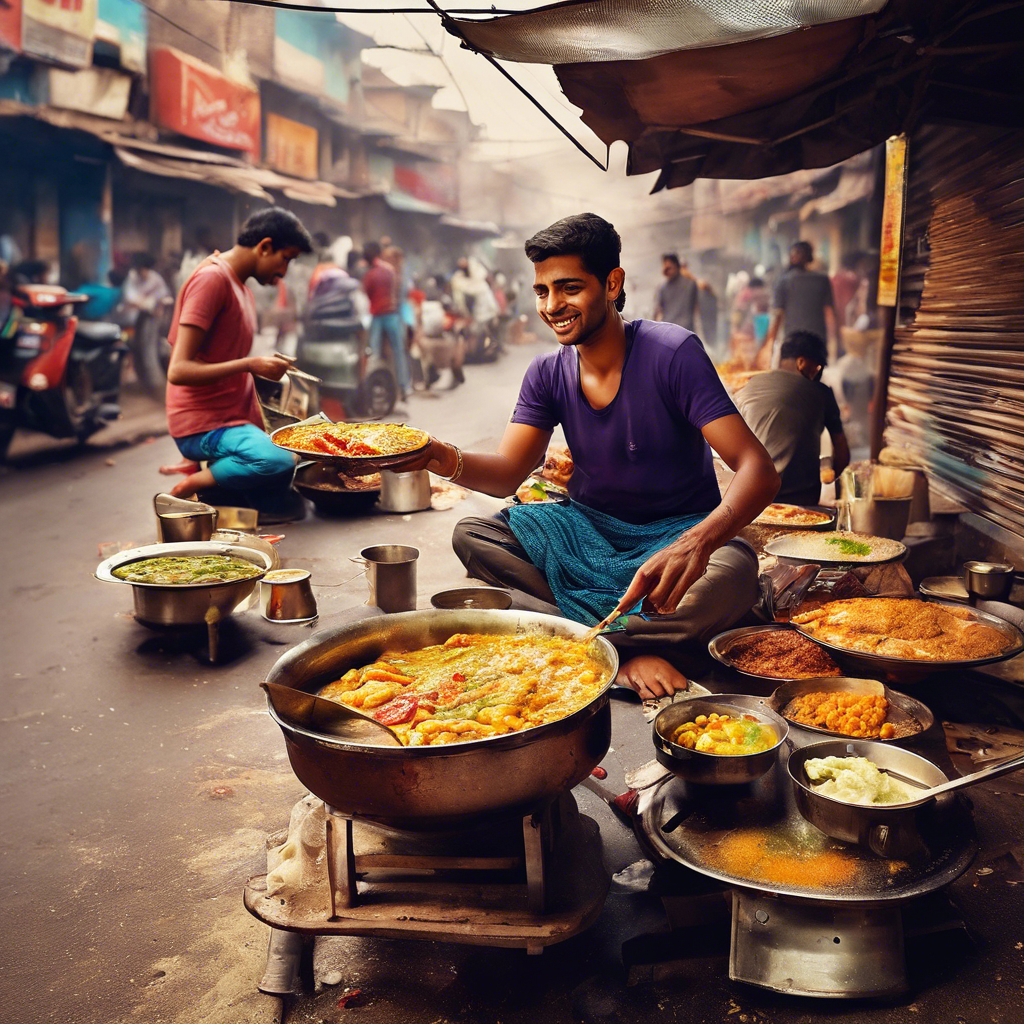
Transportation and Getting Around in Agra:
Getting around Agra, the city famous for the Taj Mahal, is relatively easy due to a variety of transportation options available for visitors. Here’s a detailed overview of the different modes of transport you can use to navigate the city and reach its many attractions.
1. Auto-Rickshaws
Auto-rickshaws are a popular and convenient mode of transportation in Agra. These three-wheeled vehicles are ideal for short distances and can be found throughout the city. It’s advisable to negotiate the fare before starting your journey or insist on using the meter to avoid overcharging. Carrying small change is also recommended for easy payments.
2. Cycle-Rickshaws
For a more eco-friendly and leisurely way to explore Agra, consider taking a cycle-rickshaw. These pedal-powered vehicles are perfect for navigating narrow lanes and crowded areas, and they are commonly found near tourist attractions. Again, negotiating the fare beforehand is essential.
3. Taxis
Taxis provide a comfortable and convenient option for getting around Agra, especially for families or those preferring a private mode of transport. Prepaid taxis are available at the Agra Cantt railway station and the airport. Additionally, app-based services like Uber and Ola are operational in Agra, offering transparent pricing and easy booking.
4. Local Buses
Agra has a local bus network that covers various parts of the city. While buses are an affordable option for longer distances, they may not be the most comfortable choice, especially during peak hours. The main bus terminal is located near the Agra Fort, where you can inquire about routes and timings.
5. Private Car Rentals
For those who prefer flexibility, renting a private car is a great option. Several car rental agencies operate in Agra, offering a range of vehicles. This allows visitors to explore the city at their own pace and visit attractions outside the city center, such as Fatehpur Sikri or Mehtab Bagh.
6. Walking
Many attractions in Agra are located close to each other, making walking a viable option. This allows families to soak in the local atmosphere, discover hidden gems, and explore the narrow lanes of the old city. However, pedestrians should be cautious of traffic and follow safety rules.
7. Getting to Agra
Agra is well-connected to major cities like Delhi and Jaipur by air, train, and road. The Agra Airport (Pandit Deendayal Upadhyay Airport) connects the city to several major Indian cities. The train service from Delhi to Agra is frequent and takes about 2-4 hours, making it a popular choice for travelers.
8. Tours and Packages
Many visitors opt for guided tours that include transportation. These tours often cover major attractions like the Taj Mahal and Agra Fort, providing a hassle-free experience. Tour packages typically include pickup and drop-off services, making it convenient for families and first-time visitors.
With a variety of transportation options available, getting around Agra is straightforward and accessible for all types of travelers. Whether you choose the convenience of taxis, the eco-friendliness of cycle-rickshaws, or the flexibility of a rented car, you can easily navigate the city and enjoy its rich history and culture. Planning your transportation in advance can enhance your experience, allowing you to focus on the stunning sights that Agra has to offer.
Wildlife and Nature in Agra:
Agra, primarily known for the Taj Mahal, is also home to various wildlife and natural attractions that offer a refreshing escape from the bustling city. Here’s an exploration of the wildlife and nature experiences you can enjoy in and around Agra.
Taj Protected Forest
The Taj Protected Forest is a serene area located near the Taj Mahal, featuring footpaths through densely wooded landscapes. This forest is a haven for birdwatchers and nature lovers, providing opportunities to spot various bird species while enjoying views of the Taj Mahal from different angles. The forest is open daily from 7 AM to 7 PM, making it an excellent spot for an early morning walk or a peaceful afternoon retreat.
Nature’s Nest Biodiversity Park
Nature’s Nest Biodiversity Park is a relatively new addition to Agra’s natural attractions. This park focuses on preserving local flora and fauna and offers visitors a chance to explore its diverse ecosystems. With well-maintained walking trails, it’s a perfect spot for families and nature enthusiasts to enjoy a day outdoors. The park is open from 6 AM to 6 PM on weekdays, with slightly shorter hours on Sundays.
Wildlife SOS – Elephant Conservation and Care Center
Located a short drive from Agra, the Wildlife SOS Elephant Conservation and Care Center is dedicated to rescuing and rehabilitating elephants from abusive conditions. Families can take guided tours to learn about the elephants, observe them in a safe environment, and even participate in feeding and bathing activities. This experience not only educates visitors about wildlife conservation but also fosters empathy towards these majestic creatures. The center is open daily from 10 AM to 5 PM.
Soor Sarovar Bird Sanctuary
The Soor Sarovar Bird Sanctuary, situated about 20 km from Agra, is a tranquil wetland area that attracts a large population of migratory and local birds. Covering approximately 15 acres, this sanctuary is ideal for birdwatching, especially during the winter months when various species flock to the area. Visitors can enjoy peaceful walks along the trails while spotting herons, pelicans, and other avian species. The sanctuary is open from 8 AM to 6 PM.
Keetham Lake
Keetham Lake is another wildlife refuge located near Agra, known for its diverse bird population, including migratory wading birds like herons and pelicans. The lake is surrounded by lush greenery and provides a peaceful setting for picnics and nature walks. It’s a great spot for families who enjoy birdwatching and photography. The lake is accessible from 6 AM to 5 PM.
Taj Nature Walk
The Taj Nature Walk is a 70-hectare wooded park located near the Taj Mahal, featuring paved walking trails that offer stunning views of the monument. This park is perfect for leisurely strolls, jogging, or simply enjoying nature. It provides an excellent opportunity for families to relax and appreciate the beauty of the surrounding landscape. The park is open from 7 AM to 6 PM.
Birdwatching Opportunities
Agra and its surrounding areas are rich in birdlife, making it a fantastic destination for birdwatchers. Apart from the mentioned sanctuaries, places like Keoladeo National Park (located about 55 km from Agra) are renowned for their diverse bird species, including the rare Siberian crane during the winter months. This UNESCO World Heritage Site is a must-visit for avid birdwatchers and nature lovers alike.
Local Flora and Fauna
In addition to the organized parks and sanctuaries, Agra’s natural environment features a variety of local flora and fauna. Families can explore the region’s diverse ecosystems, which include various species of trees, plants, and wildlife. Engaging with nature in this way can be educational and enjoyable for children and adults alike.
Eco-Tourism Activities
Agra is increasingly focusing on eco-tourism, with initiatives aimed at preserving its natural heritage. Visitors can participate in eco-friendly activities such as guided nature walks, birdwatching tours, and wildlife photography workshops, which not only enhance their experience but also contribute to conservation efforts.
Nearby Wildlife Sanctuaries
For those willing to venture a bit further, several renowned wildlife sanctuaries and national parks are within a few hours’ drive from Agra. These include:
Keoladeo National Park: A UNESCO World Heritage Site known for its rich birdlife and diverse ecosystems.
Ranthambore National Park: Famous for its tiger population and diverse wildlife, located about 270 km from Agra.
Jim Corbett National Park: One of India’s oldest national parks, known for its rich biodiversity, located approximately 300 km from Agra.
Agra offers a variety of wildlife and nature experiences that complement the historical allure of the Taj Mahal. From serene parks and sanctuaries to educational conservation centers, there are plenty of opportunities for families and nature enthusiasts to explore the region’s natural beauty. Whether you’re birdwatching, enjoying a peaceful walk, or learning about wildlife conservation, Agra’s natural attractions provide a refreshing escape and a deeper connection to the environment.
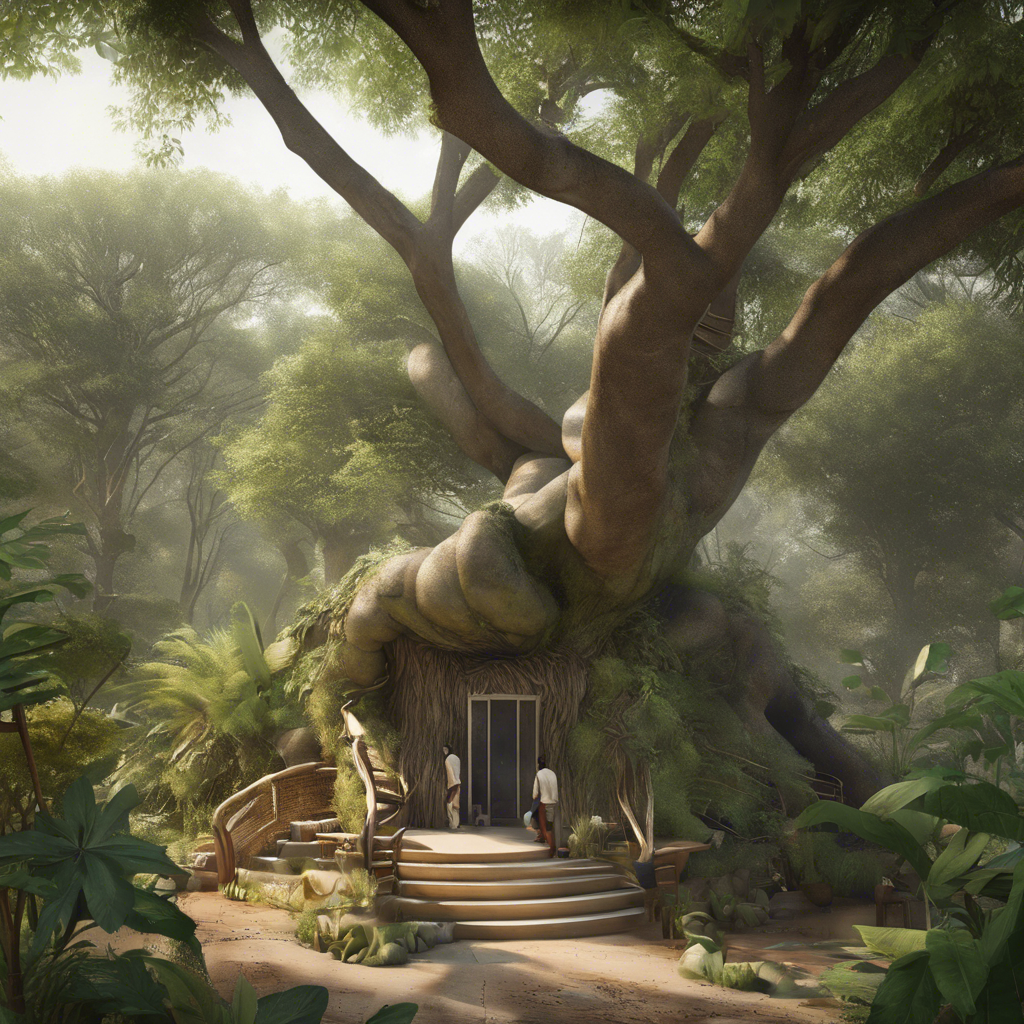
Travel Tips for Visiting the Taj Mahal in 2024:
Visiting the Taj Mahal is a once-in-a-lifetime experience, and planning ahead can make your trip even more enjoyable. Here are some essential travel tips for visiting the Taj Mahal in 2024:
1. Best Time to Visit
Optimal Seasons: The best time to visit the Taj Mahal is from October to March, when the weather is pleasant. However, if you want to avoid crowds, consider visiting during the shoulder months of March/April and September/October.
Sunrise Visits: Arriving at sunrise is highly recommended. The monument looks stunning in the early morning light, and the crowds are significantly smaller compared to later in the day. Aim to arrive at least one hour before sunrise to get through security and enjoy the serene atmosphere.
2. Ticket Information
Purchase Tickets in Advance: It’s advisable to buy your tickets online to avoid long queues at the entrance. Tickets can be purchased from the official website or authorized vendors. International visitors pay around ₹1,100 (approximately $14), while Indian citizens pay ₹50. Children under 15 years old can enter for free.
Entry Points: The Taj Mahal has three gates: the Eastern Gate, Western Gate, and Southern Gate. The Southern Gate is only for exiting. The Eastern Gate is often busier with tour groups, so consider using the Western Gate for a quieter entry.
3. Time Allocation
Plan for Three Hours: Allocate at least three hours for your visit to fully explore the complex, take photos, and appreciate the intricate details of the monument. Note that the maximum time allowed inside is three hours, and if you overstay, you may incur additional charges.
4. Dress Appropriately
Comfortable Clothing: Wear light, breathable clothing, especially during the warmer months. If visiting in winter, bring a jacket for the cooler mornings. Comfortable walking shoes are essential, as there is a lot of walking involved.
Shoe Covers: Shoe covers are mandatory when entering the mausoleum. These are provided for international ticket holders, but if you’re purchasing an Indian ticket, be sure to bring your own or buy them at the entrance.
5. Security Checks
Security Procedures: Expect thorough security checks at the entrance. Large bags, food, tripods, and battery packs are prohibited. If you have a large bag, consider renting a locker at the entrance.
6. Photography Tips
Capture the Moment: The Taj Mahal is a photographer’s dream, but to get that perfect shot without crowds, arrive early. The iconic bench directly in front of the monument is a popular spot for photos.
Best Angles: Explore different viewpoints around the complex for unique perspectives. The gardens and the reflecting pools provide excellent backdrops.
7. Additional Attractions
Explore Nearby Sites: Consider visiting Agra Fort and the Tomb of Itimad-ud-Daulah (also known as the Baby Taj) for more Mughal architecture. These sites are close to the Taj Mahal and can be easily included in your itinerary.
Mehtab Bagh: This garden located across the Yamuna River offers stunning views of the Taj Mahal, especially at sunset. It’s less crowded and perfect for a peaceful stroll.
8. Transportation
Getting There: Agra is well connected by train, bus, and road. The Shatabdi Express is a popular train option from Delhi, taking about 2-3 hours. Booking train tickets in advance is recommended.
Local Transport: Once in Agra, use auto-rickshaws, cycle-rickshaws, or taxis to get around. Walking is also a great way to explore the area, especially near the Taj Mahal.
9. Stay Hydrated and Snack Smart
Bring Water: Stay hydrated, especially if you’re visiting during the warmer months. You can bring a water bottle, as it’s allowed inside the complex.
Dining Options: After your visit, enjoy a meal at one of the rooftop restaurants near the Taj Mahal, which offer great views of the monument.
10. Respect the Site
Cultural Sensitivity: The Taj Mahal is a mausoleum and holds great cultural significance. Be respectful during your visit, and follow the rules regarding photography and behavior.
Conclusion
Visiting the Taj Mahal is an unforgettable experience filled with history, beauty, and romance. By planning ahead and following these travel tips, you can ensure a smooth and enjoyable visit to this iconic monument in 2024. Whether you’re admiring its architectural grandeur or capturing the perfect photograph, the Taj Mahal is sure to leave a lasting impression.
The Taj Mahal is a true wonder of the world, a testament to the power of love and human ingenuity. Whether you’re a history buff, a nature lover, or simply someone who appreciates beauty, a visit to the Taj Mahal is an experience you’ll never forget.
So, what are you waiting for? Start planning your trip to the Taj Mahal in 2024 and get ready to be swept away by its timeless beauty and enchanting atmosphere. With our comprehensive guide, you’ll be able to make the most of your visit and create memories that will last a lifetime.




